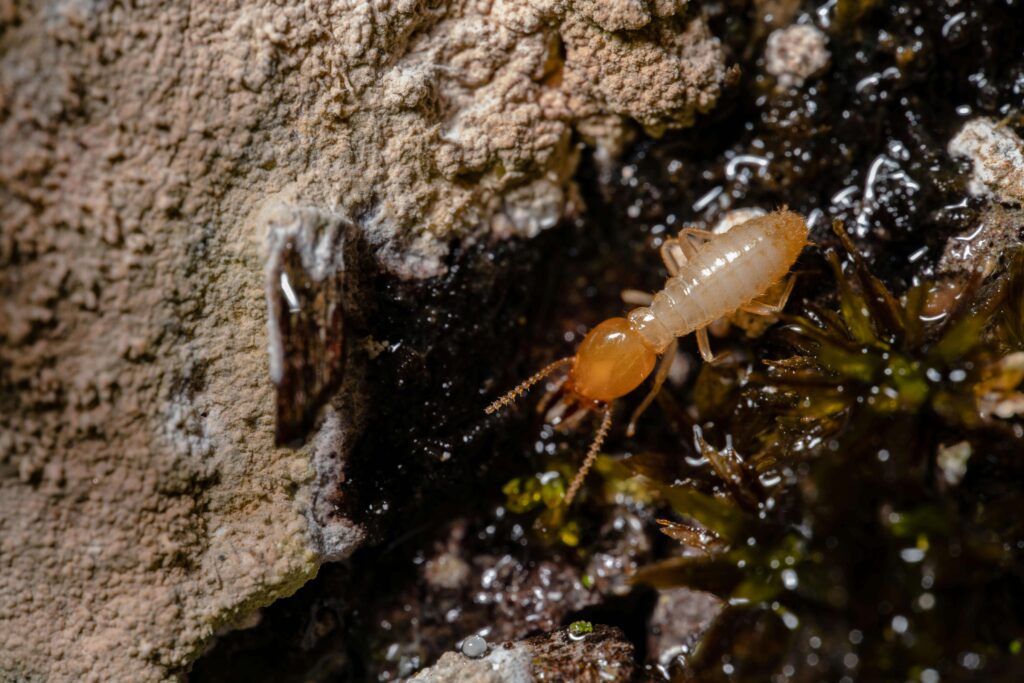Think you might have termites? Educate yourself on how to identify the early signs of termite infestations so you can take action quickly. If left untreated, termites can cause extreme damage to your home, potentially costing thousands to repair the wood damage. As all of the U.S. is at risk for termites, the National Pest Management Association estimated in 2024 that the annual cost of termite damage is $6.8 billion.
At ProForce Pest Control, our termite experts across the southeast are Certified Sentricon Specialists. Sentricon is a standalone termite control solution that works to eliminate entire subterranean termite colonies. To take care of any non-subterranean (drywood) termites, we utilize a spot liquid treatment.
Keep reading to learn how to identify early warning signs for termite damage to protect your property before irreversible damage is done:
What Are the Early Signs of Termite Activity?
- Wood Pellets/Shavings (Frass)
- Discarded Wings
- Actively swarming Termites
What Are the Advanced Signs of Termite Damage?
- Surface Blisters on Wood
- Damaged Wood
- Mud Tubes
- Wall and Ceiling Wet Spots
- Mildew or Mold Smell
1. Wood Pellets/Shavings (Frass)
Frass is the byproduct of termites eating your wood. Typically found in piles near floors, under furniture, or by windows, termite frass can be identified as a cream or reddish-brown color and is about 1-2 mm long.
2. Discarded Wings
With a termite infestation, it’s possible to find discarded wings on window sills, doors, or in spiderwebs.
3. Swarming Termites
Watch out for swarming termites at night; these are mating flights (otherwise known as nuptial flights). According to the State of Florida Department of Agriculture and Consumer Services, the typical peak season for swarms is late spring and summer. You can identify termite swarms easily by looking at their wings; all of their wings are roughly the same size, whereas ants, on the other hand, have differently sized front and back wings.
4. Surface Blisters on Wood
Surface blisters can be found on wood as termites get closer to the surface of your floors and walls. Blisters can be identified by spots or bubbles on the surface of your floors, baseboards, stairs, walls, or ceilings, indicating that the top layer of the wood has separated from the bottom layers.
5. Damaged Wood
If you notice blisters on wood and other damage to your floors, window sills, and walls, that is a strong indicator of a termite infestation. The easiest way to tell if your wood is damaged is to test the durability by tapping with a screwdriver to hear if the wood is hollow. If the damage is late stage, you might even see the wood crack or crumble from your tapping.
6. Mud Tubes/Shelter Tubes/Tunnels
Termites will make tunnels of soil and sand, called mud tubes or shelter tubes, to travel between the soil and the wood in your house. You will typically find them close to the soil, so they are often spotted in basements.
7. Wall and Ceiling Wet Spots
Specifically with subterranean termites, it’s common to spot what look like wet spots as an indicator of a termite infestation. Subterranean termites require moisture to thrive.
8. Mildew/Mold Smell
A mold or mildew smell near baseboards, windows, or beams is a common sign of subterranean termite activity. Because they need to remain in a moist environment, the termites bring moisture into the structure, which can encourage fungal growth.
Termite FAQs
While some of the signs of termite activity are similar to water damage (ie. mildew smell, wet spots, blistering), be sure to check for any of the other termite indicators such as mud tubes or frass.
No, they do not pose a risk to humans as termites very rarely bite humans. The risk is geared towards home damage.
In states like Florida, Georgia, and the Carolinas, termite activity peaks in the spring and summer. They are especially active after heavy rain on humid evenings during the warmer months.
Subterranean termites live underground and need moisture to survive, and are often associated with water damage signs. Drywood termites do not retreat to the soil and have adopted a way to retain moisture, so they are frequently found in wood floors, attics, wood frames, window sills, doors, and furniture of older homes.
Contact a Termite Expert in Your Area
Termites can be a problem all over the US, but they are especially prevalent in the southern states with warmer climates. Subterranean termites that prefer a moist environment have become rampant in coastal areas, such as Florida, Georgia, the Carolinas, and Virginia.
If you spot one or multiple termite damage signs, contact one of our termite experts. If you live in an area known for excessive termite species, such as Florida, and want to implement termite control before any issues arise, we’re the pros for the job. We have 11 locations across Florida, Georgia, North Carolina, South Carolina, and Virginia that handle termite protection, covering both subterranean and drywood termites (non-subterranean).


